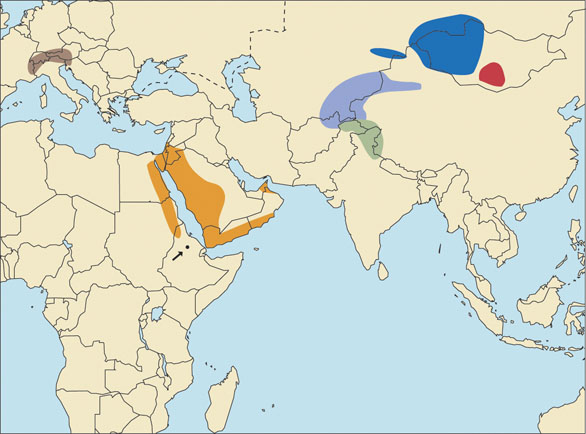 |
 |
Capra ibex
Cabra Apina (Sp), Alpensteinbock (G), Bouquetin des Alpes (F). Also called European ibex.
DESCRIPTION (male) Shoulder height 30-34 inches (76-86 cm). Weight 225-275 pounds (102-125 kg). Females are smaller.
The Alpine ibex is a stocky animal, darker in color than other ibexes. The upper parts are a uniform grayish-brown (lighter in summer and darker in winter), separated from the pale underparts by a darker brown band. The legs, upper surface of tail and forehead are also a darker brown. Males have a small beard and large, impressive horns that are shorter, thicker and straighter than those of other ibexes. Females have very small horns and no beard.
BEHAVIOR Gregarious, with females and young in small herds, and males solitary or in small bachelor groups. Mates in December, with one (sometimes two) kids born in the spring. Feeds mostly on grasses, but also eats shrubs and lichens. Very agile and surefooted on steep terrain.
HABITAT High mountains, normally above the treeline and at or below the snowline. Ibexes evolved in arid mountains with little snow, and were never widely distributed in the Alps. Good ibex range is limited to mountains with little precipitation and with sunny, snow-free areas where the animals can survive the winter.
DISTRIBUTION Originally throughout the Alps and also in other European mountains, but became extinct except in the Piedmont region of northwestern Italy. Free-ranging populations have since been re-established elsewhere in Italy, and also in Switzerland, Austria and adjacent parts of France, Germany and Slovenia. Once again numerous in some areas, with the largest populations in Switzerland. Also reintroduced in 1901 in the High Tatra Mountains on the borders of Slovakia and Poland, where they are said to have hybridized with subsequently introduced Nubian ibex and bezoar ibex; however, these animals appear to have died out. Many Alpine ibexes are also found in private herds on fenced properties.
Outside Europe, Alpine ibexes have been introduced on private properties in Argentina and elsewhere.
REMARKS As with other European animals, the recent history of Alpine ibexes is a conservation success story. By the mid 1800s, only a few dozen ibexes survived in the Piedmont region of northern Italy, the others having perished because of modern weaponry and the supposed medicinal value of their horns and bezoar stones. (In most cases, game laws had little effect. The Archbishop of Salzburg once had a poacher sewn in a fresh deer hide and allowed his hounds to rip the unfortunate man to shreds, but ibex poaching went on regardless.) Alpine ibex were saved from extinction when King Victor Emanuel II of Italy created Gran Paradiso National Park in the northwestern part of that country and successfully protected the resident animals. Because the Italians refused to share their surviving ibexes with other countries, live specimens were eventually stolen from Gran Paradiso and bred near St. Gallen, Switzerland. Together with other smuggled animals (including a virile male, "Wucki"), the populations outside Italy rebuilt. Today, Alpine ibexes are believed to number about 22,000 and are increasing, with restocking efforts continuing.
Alpine ibexes are available to foreign hunters in Austria and Slovenia, and in Switzerland by special permit. When free-ranging, they offer excellent sport and are one of Europe's most prestigious big game animals because of their relative scarcity, the difficult terrain they inhabit, and the quality of the hunting experience. They also can be collected on fenced private properties where they often grow better horns than those of free-ranging animals; however, the quality of the hunting experience may not be the same.
PLEASE NOTE Trophy fees for Alpine ibexes are normally set according to trophy size, and one should be aware that ranch hybrids between Alpine ibex and other forms that have longer horns have occasionally been passed off on unsuspecting clients as purebred animals at high prices. Such hybrids will not qualify for the Record Book. Prospective hunters should learn to identify pure Alpine ibexes before taking to the field.
TAXONOMIC NOTES Biologists consider the Alpine ibex to be a "true" ibex, along with the Nubian, walia and Asian ibexes. All are characterized by large impressive horns that are triangular in cross-section and have a relatively flat frontal surface carrying well-defined cross ridges or knobs. The true ibexes are the most widely distributed of wild goats, occurring from central Europe to northeastern Africa and central Asia. They have adapted to a wide range of environments, evolving different characteristics in the process, and many different forms have been described and named. These have been treated as full species by some authorities and as subspecies by others, with no general consensus. We elect to follow those who regard the Alpine, Nubian, walia and Asian ibexes as full species. Of these, only the Alpine ibex is found in Europe.
|





